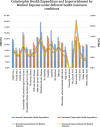Targeting vulnerable groups of health poverty alleviation in rural China- what is the role of the New Rural Cooperative Medical Scheme for the middle age and elderly population?
- PMID: 32928229
- PMCID: PMC7489030
- DOI: 10.1186/s12939-020-01236-x
Targeting vulnerable groups of health poverty alleviation in rural China- what is the role of the New Rural Cooperative Medical Scheme for the middle age and elderly population?
Abstract
Background: In light of the health poverty alleviation policy, we explore whether the New Rural Cooperative Medical System (NRCMS) has effectively reduced the economic burden of medical expenses on rural middle-aged and elderly people and other impoverished vulnerable groups. The study aims to provide evidence that can be used to improve the medical insurance system.
Methods: Data were obtained from the 2015 China Health and Retirement Longitudinal Study (CHARLS). The method of calculating the catastrophic health expenditure (CHE) and impoverishment by medical expense (IME) was adopted from the World Health Organization (WHO). The treatment effect model was used to identify the determinants of CHE for rural middle-aged and elderly people.
Results: The incidence of CHE in rural China for middle-aged and elderly people is 21.8%, and the IME is 8.0%. The households that had enrolled in the NRCMS suffered higher CHE (21.9%) and IME (8.0%), than those that had not enrolled (CHE: 20.6% and IME: 7.7%). The NRCMS did not provide sufficient economic protection from CHE for households with three or more chronic diseases, inpatients, or households with members aged over 65 years. Key risk factors for the CHE included education levels, households with inpatients, households with members aged over 65 years, and households with disabilities.
Conclusions: Although the NRCMS has reduced barriers to the usage of household health services by reducing people's out-of-pocket payments, it has not effectively reduced the risk of these households falling into poverty. Our research identifies the characteristics of vulnerable groups that the NRCMS does not provide enough support for, and which puts them at a greater risk of falling into poverty due to health impoverishment.
Keywords: China; Health poverty alleviation; Middle-aged and elderly people; New rural cooperative medical system; Vulnerable population.
Conflict of interest statement
The authors declare that they have no competing interests.
Figures
Similar articles
-
Does the medical insurance system really achieved the effect of poverty alleviation for the middle-aged and elderly people in China? Characteristics of vulnerable groups and failure links.BMC Public Health. 2020 Apr 3;20(1):435. doi: 10.1186/s12889-020-08554-3. BMC Public Health. 2020. PMID: 32245435 Free PMC article.
-
Health poverty reduction effect of medical insurance in China's middle-aged and elderly populations: a cross-sectional study.BMJ Open. 2025 Apr 27;15(4):e085226. doi: 10.1136/bmjopen-2024-085226. BMJ Open. 2025. PMID: 40288789 Free PMC article.
-
What fragile factors hinder the pace of China's alleviation efforts of the poverty-stricken population? A study from the perspective of impoverishment caused by medical expenses.BMC Health Serv Res. 2022 Jul 29;22(1):963. doi: 10.1186/s12913-022-08237-2. BMC Health Serv Res. 2022. PMID: 35906603 Free PMC article.
-
Understanding variations in catastrophic health expenditure, its underlying determinants and impoverishment in Sub-Saharan African countries: a scoping review.Syst Rev. 2018 Sep 11;7(1):136. doi: 10.1186/s13643-018-0799-1. Syst Rev. 2018. PMID: 30205846 Free PMC article.
-
Economic status and catastrophic health expenditures in China in the last decade of health reform: a systematic review and meta-analysis.BMC Health Serv Res. 2021 Jun 24;21(1):600. doi: 10.1186/s12913-021-06408-1. BMC Health Serv Res. 2021. PMID: 34167527 Free PMC article.
Cited by
-
Changing inequity in health service utilization and financial burden among patients with hypertension in China: evidence from China Health and Retirement Longitudinal Study (CHARLS), 2011-2018.Int J Equity Health. 2023 Nov 24;22(1):246. doi: 10.1186/s12939-023-02062-7. Int J Equity Health. 2023. PMID: 38001484 Free PMC article.
-
Multimorbidity and catastrophic health expenditure: Evidence from the China Health and Retirement Longitudinal Study.Front Public Health. 2022 Oct 26;10:1043189. doi: 10.3389/fpubh.2022.1043189. eCollection 2022. Front Public Health. 2022. PMID: 36388267 Free PMC article.
-
The Comparison of Various Types of Health Insurance in the Healthcare Utilization, Costs and Catastrophic Health Expenditures among Middle-Aged and Older Chinese Adults.Int J Environ Res Public Health. 2022 May 13;19(10):5956. doi: 10.3390/ijerph19105956. Int J Environ Res Public Health. 2022. PMID: 35627490 Free PMC article.
-
Health Poverty Alleviation Project in Rural China: Impact on Poverty Vulnerability, Health Status, Healthcare Utilization, Health Expenditures.Risk Manag Healthc Policy. 2023 Dec 8;16:2685-2702. doi: 10.2147/RMHP.S438352. eCollection 2023. Risk Manag Healthc Policy. 2023. PMID: 38095012 Free PMC article.
-
Cancer screening in China: a steep road from evidence to implementation.Lancet Public Health. 2023 Dec;8(12):e996-e1005. doi: 10.1016/S2468-2667(23)00186-X. Epub 2023 Nov 21. Lancet Public Health. 2023. PMID: 38000379 Free PMC article. Review.
References
-
- The Word Bank Data. https://data.worldbank.org.cn/indicator/SI.POV.DDAY?locations=1W&start=1... Accessed 1 Jun 2020.
-
- Sumner A. Where do the poor live? World Dev. 2012;40(5). 10.1016/j.worlddev.2011.09.007 Accessed 1 Jun 2020.
-
- United Nations draft outcome document of the United Nations Summit for the adoption of the Post-2015 Development Agenda. 2015. https://sustainabledevelopment.un.org/sdg1 Accessed 1 Jun 2020.
-
- The National Bureau of Statistics of China . The series of economic and social development achievements in the 40 years of reform and opening up. 2018.
-
- United Nations (UN) The Millennium Development Goals Report 2015. 2015.
Publication types
MeSH terms
LinkOut - more resources
Full Text Sources
Medical



